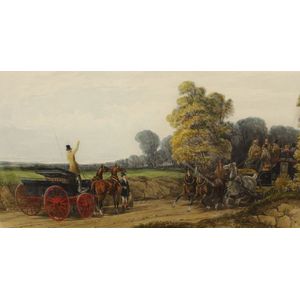Bird's Eye Maple Aquatint for Coach
You must be a subscriber, and be logged in to view price and dealer details.
Subscribe Now to view actual auction price for this item
When you subscribe, you have the option of setting the currency in which to display prices to $Au, $US, $NZ or Stg.
- Bird's Eye Maple - Bird's eye maple is a type of wood that is characterized by its unique, small, round eyes or spots that are scattered throughout the wood. These spots are caused by a genetic defect in the tree, and they give the wood a distinctive, swirling pattern that is highly sought after by woodworkers and furniture makers.
Bird's eye maple is harvested from the hard maple tree, which is native to Northern Europe and North America. The wood is generally pale in colour, with shades of cream, white, or light brown. The bird's eye figure is most seen in hard maple, but it can also be found in other species of maple such as the big leaf maple and silver maple, but hard maple is the most common.
It became fashionable in furniture manufacturing for use as a decorative veneer from the late 18th century to the late 19th century.
As well as furniture making, it is also used in musical instruments such as guitar, drums, and pianos and smaller decorative items such as various type of boxes such as tea caddies and in picture frames. - Maple - Maple, native to North America, is a dense heavy timber from light to yellow-brown in colour. It has very little distincive graining unless it is one of the variants such as birds-eye maple or burr maple, so was not used extensively for furniture in 18th and 19th century, where cabinetmakers and designers preferred timbers with more distinctive features such as mahogany, walnut, rosewood and oak.
Birds-eye maple has a seres of small spots linked by undulating lines in the grain, is highly sough and is used as a decorative veneer. Burr maple has larger and irregular grain swirls than birds-eye maple. - Aquatint - The arabesque pattern is an ornamental design that features flowing, curving lines and elaborate geometric shapes. It is inspired by the art and architecture of the Islamic world and was developed at Fontainebleu France in the mid 16th century. Its use was spread through published engravings, and it is characterized by its intricate and highly decorative nature. The arabesque pattern is created using a repetitive motif that is repeated and interwoven to create a cohesive design. It was used as a form of decoration in art, architecture, textiles, pottery, furniture and ceramics and it is often used to add a sense of grandeur and sophistication to a design. The arabesque pattern is admired for its beauty and complexity, and it continues to be used in a wide range of decorative contexts today.
This item has been included into following indexes:
Visually similar items

Initialed J width By the Village Gate, oil on panel, initialed and dated J W 81 lower left, 25 x 37 cm

Isa Lane, (19th century) Australia, Faries (sic) at the back (barn of?), oil on canvas, signed lower right, 20 x 32.5 cm

Clarrie Cox (b.1927) the Ulan Hotel, oil on board, signed lower right 54 cm x 90 cm

Dora Toovey (1898-1990). The Deserted Mill, Malmsbury 1971. Oil on canvas. Signed & dated lower left. Titled verso, many times. 40 x 50 cm
